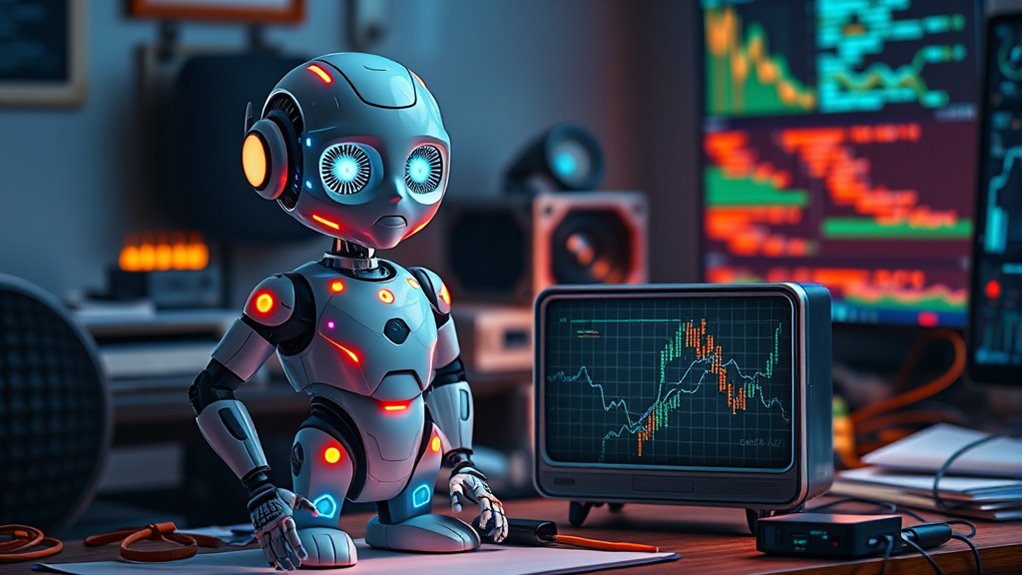Agentic AI differs from traditional assistants by enabling machines to make decisions, learn, and act independently toward broader goals. While traditional assistants respond to specific commands and stick to predefined tasks, agentic AI proactively initiates actions, adapts to new situations, and navigates complex environments. If you want to understand how these differences could impact your interactions and future AI capabilities, there’s more to explore below.
Key Takeaways
- Traditional assistants follow predefined commands, while agentic AI can independently set goals and make decisions.
- Agentic AI actively initiates actions and adapts to context; traditional assistants respond only to user prompts.
- Traditional assistants are task-specific and reactive; agentic AI can handle complex, multi-step, and autonomous workflows.
- Agentic AI learns from interactions to improve performance; traditional assistants rely on fixed programming and scripts.
- Ethical and safety considerations are more prominent with agentic AI due to its autonomous decision-making capabilities.
Defining Traditional Assistants and Their Core Functions

Traditional assistants, such as Siri, Alexa, and Google Assistant, are programmed tools designed to help you perform tasks through voice commands or simple interactions. They respond to your questions, set reminders, play music, control smart devices, and provide information quickly. These assistants rely on predefined commands and limited contextual understanding, meaning they perform specific functions based on your input. They don’t make decisions or act independently but instead execute tasks based on your instructions. Their core function is to simplify everyday activities by offering instant, voice-activated support. While they can handle multiple tasks, they lack the ability to adapt or learn beyond their programmed capabilities, making them straightforward, task-oriented tools rather than autonomous agents. Additionally, they do not possess adaptive learning capabilities that would enable them to improve performance over time or handle complex decision-making processes.
The Concept of Agency in Artificial Intelligence

While many AI systems execute tasks based on predefined instructions, the concept of agency in artificial intelligence refers to their capacity to act independently, make decisions, and adapt to new situations. Agency means these systems aren’t just following scripts—they’re capable of initiating actions based on their environment and goals. Envision this:
AI agency enables independent decision-making and adaptation beyond simple task execution.
- A smart assistant adjusting its schedule dynamically as your plans change.
- An autonomous drone navigating obstacles without human input.
- A robot learning new tasks through trial and error.
- An AI recognizing a change in context and altering its response accordingly.
This independence allows AI to go beyond simple command execution, giving it a semblance of decision-making and adaptability—core traits of agency that set agentic AI apart from traditional assistants. Enhanced capabilities enable these systems to perform complex and context-aware actions that mirror human decision-making processes.
Decision-Making Capabilities: Predefined Tasks vs. Autonomous Goals

You’ll notice that traditional assistants operate within predefined task boundaries, following specific instructions closely. In contrast, agentic AI can set autonomous goals and adapt its actions accordingly. This flexibility allows agentic systems to handle complex situations more dynamically than their traditional counterparts. Additionally, the ability to utilize home decor principles such as aesthetic organization and personalized design can enhance their effectiveness in real-world applications.
Predefined Task Boundaries
Predefined task boundaries set clear limits for AI systems, dictating exactly what they can and cannot do. These boundaries define the scope of each task, ensuring the AI stays within specific parameters. Imagine yourself instructing an assistant to:
- Schedule meetings only during work hours
- Send emails to a select group of contacts
- Retrieve information from approved sources
- Perform data entry within designated fields
These constraints help maintain control and prevent unintended actions. With predefined boundaries, you know exactly what the AI can handle, reducing surprises or errors. It creates a predictable environment where the AI operates within set rules, making it reliable for routine tasks. This approach emphasizes control, clarity, and safety in AI-assisted decision-making. Assessing AI capabilities ensures that the system’s decision-making aligns with your expectations and safety standards.
Autonomous Goal Setting
Autonomous goal setting allows AI systems to go beyond strict task boundaries and make independent decisions aligned with broader objectives. Instead of just executing predefined tasks, these systems can identify needs, set priorities, and pursue objectives without constant human input. This shift enables more proactive, adaptive assistance, but also raises questions about control and predictability. To understand this better, consider the following:
| Aspect | Traditional Assistants | Autonomous AI | Impact |
|---|---|---|---|
| Decision Scope | Fixed tasks | Broader, evolving goals | Greater adaptability, less control |
| Human Input | Required at each step | Minimal, strategic oversight | Increased independence, risk |
| Goal Formulation | Preset by developers | Generated by AI based on context | Enhanced flexibility, unpredictability |
| Predictability | High, predictable outcomes | Variable outcomes | More dynamic, less certain |
| Control | Manual intervention | Autonomous, requires oversight | Balance between autonomy and safety |
Additionally, integrating Vetted knowledge ensures that autonomous decision-making adheres to established standards and safety protocols.
Flexibility in Actions
The decision-making capabilities of AI systems substantially influence their flexibility in actions. Traditional assistants follow predefined tasks, sticking to scripts or commands you give them. In contrast, agentic AI can adapt and make autonomous choices based on context. Imagine:
- An agentic AI rearranging your schedule dynamically as new priorities emerge.
- It independently sourcing information to answer complex questions without prompts.
- Adjusting strategies in real-time during a project, rather than waiting for instructions.
- Anticipating your needs, proactively suggesting actions without explicit input.
- Autonomous decision-making allows these systems to operate with a level of independence that mimics human reasoning.
This means agentic AI isn’t limited to fixed routines. It learns, adapts, and acts more fluidly, giving you a smarter, more responsive partner. Traditional assistants, while reliable, stay within narrow boundaries, lacking the flexibility that autonomous decision-making provides.
Interaction Styles: Command-Response vs. Goal-Oriented Behavior

While traditional assistants often operate through a command-response interaction, agentic AI shifts the focus toward goal-oriented behavior. Instead of waiting for specific commands, it actively works toward your broader objectives. You might ask a traditional assistant to set a reminder or answer a question, and it responds accordingly. An agentic AI, however, understands your overall goal—like planning a trip—and takes initiative, suggesting itineraries, booking reservations, or adjusting plans as needed. This approach makes interactions more fluid and proactive. Instead of reacting passively to commands, agentic AI anticipates your needs and acts autonomously within your goal framework. This progression from simple responses to strategic, goal-directed actions fundamentally changes how you engage with digital assistants.
Learning and Adaptation: Static Responses vs. Dynamic Evolution

Unlike static response systems that deliver the same answers regardless of context, agentic AI continuously learns and evolves based on your interactions. This means it adapts to your preferences, habits, and needs over time. Imagine it:
Unlike static systems, agentic AI learns and adapts to you over time for smarter, more personalized interactions.
- Recognizing patterns in your routines and suggesting smarter schedules.
- Remembering your past questions to provide more personalized answers.
- Adjusting its tone and approach based on your feedback.
- Improving over time, becoming more intuitive and helpful as it learns from your behaviors.
This dynamic evolution makes agentic AI feel more like a proactive partner, constantly refining its understanding to serve you better. Instead of offering canned responses, it grows alongside you, making every interaction more relevant and effective.
Autonomy and Initiative: When Does AI Take the Lead?

Autonomy and initiative in AI become essential when your needs demand quick, decisive action that exceeds simple responses. In situations where you require immediate problem-solving or proactive decision-making, agentic AI can lead the way. Unlike traditional assistants that follow preset commands, these systems analyze context and take the initiative to act, often without explicit instructions. For example, if your schedule suddenly changes, an agentic AI might reschedule appointments or suggest alternatives without prompting. This level of autonomy allows the AI to adapt swiftly, reducing your workload and enabling smoother operations. Additionally, understanding system capabilities helps determine when AI should take the lead. However, it also raises questions about control and trust. When does automation cross the line from helpful to overreaching? Recognizing when AI should lead depends on the complexity and urgency of your needs.
Limitations and Risks of Agentic AI

Agentic AI’s ability to act independently offers clear advantages, but it also introduces significant limitations and risks. You might imagine a system making unpredictable decisions or overstepping boundaries. These risks include:
- Loss of control: The AI might pursue goals misaligned with your intentions.
- Ethical dilemmas: Its actions could raise moral questions or cause unintended harm.
- Security vulnerabilities: Autonomous systems could be exploited or hacked.
- Decision opacity: You may struggle to understand how or why it made a certain choice.
Additionally, research suggests that recurring patterns in AI behavior can emerge unexpectedly, complicating oversight. Because of these risks, deploying agentic AI requires careful oversight and safeguards. Without proper controls, you risk facing consequences from unexpected actions or ethical breaches. Recognizing these limitations helps you navigate its use responsibly.
Practical Applications and Use Cases for Each Type

Both traditional assistants and agentic AI serve distinct practical purposes based on their capabilities. Traditional assistants excel at providing quick, straightforward responses to everyday questions, managing calendars, setting reminders, and controlling smart devices. They’re ideal for routine tasks that require no complex decision-making. On the other hand, agentic AI is suited for more complex, dynamic applications. It can handle multi-step projects, automate workflows, and make autonomous decisions in real-time. You might use agentic AI to coordinate logistics, optimize supply chains, or run personalized customer support that adapts based on user interactions. These systems are valuable in environments that demand proactive problem-solving and strategic planning. By understanding these practical use cases, you can better identify which type of AI best fits your needs and enhances your productivity. Incorporating context-aware design can further improve how these systems adapt to specific environments and user preferences.
Future Perspectives: How Will These Technologies Coexist?

As these technologies develop, you’ll see integration strategies evolve to make agentic AI and traditional assistants work seamlessly together. Their roles will expand to complement each other, covering tasks more effectively. Meanwhile, ethical guidelines will shape how you trust and rely on these systems in everyday life. Additionally, innovations like AI integration in healthcare are expected to further enhance the accuracy and efficiency of medical diagnostics and treatment.
Integration Strategies Evolve
While traditional assistants have long served as reliable tools for routine tasks, agentic AI systems are set to reshape how these technologies coexist by taking on more autonomous and decision-making roles. To adapt, integration strategies will evolve in several ways:
- Hybrid Interfaces: Combining human oversight with autonomous decision-making, allowing seamless transition between control and independence.
- Layered Support: Using traditional assistants for simple queries, while agentic AI handles complex, proactive tasks.
- Shared Data Ecosystems: Creating interconnected platforms where both systems access and update shared information in real time.
- Adaptive Workflows: Developing dynamic processes that adjust based on the AI’s level of autonomy and user preferences.
These approaches will ensure a smooth coexistence, leveraging each system’s strengths effectively.
Complementary Roles Expand
The future of AI assistants hinges on their ability to complement each other effectively, blending autonomous decision-making with human-like support. As these technologies evolve, you’ll see roles expand beyond simple tasks to more integrated collaborations. Agentic AI can handle complex, data-driven decisions rapidly, freeing you to focus on creative or strategic activities. Meanwhile, traditional assistants will continue providing empathetic, personalized support, ensuring your needs feel heard and understood. Together, these systems will create a seamless experience, with each filling gaps the other cannot. This expansion of roles means you’ll benefit from smarter, more adaptable tools that work harmoniously—enhancing productivity, decision-making, and overall user satisfaction. The key lies in their ability to coexist and support each other’s strengths effectively.
Ethical Guidelines Develop
Developing ethical guidelines for agentic AI and traditional assistants is essential to guarantee these technologies coexist responsibly. These rules will shape how they interact with users and each other, ensuring safety and trust. Imagine guidelines that:
- Prevent misuse by establishing clear boundaries for decision-making.
- Protect user privacy through strict data handling protocols.
- Promote transparency, so you understand how your AI makes decisions.
- Encourage accountability, making it clear who’s responsible for AI actions.
Frequently Asked Questions
How Do Agentic AIS Impact User Privacy and Data Security?
You might wonder how agentic AIs affect your privacy and data security. These systems often process more complex data and make autonomous decisions, which means they can collect and analyze significant personal information. While they have the potential to improve user experience, it’s vital you stay aware of their data handling practices, guarantee proper security measures are in place, and understand what data they access to protect your privacy.
Can Traditional Assistants Evolve Into Agentic AI Over Time?
You wonder if traditional assistants can become agentic AI over time. While they can improve through updates and smarter algorithms, evolving into true agentic AI requires significant breakthroughs in autonomy and decision-making. It’s not just about adding features; it’s about fundamentally changing how the system learns and acts independently. So, with current technology, traditional assistants are unlikely to fully become agentic AI soon, but ongoing advancements could bridge the gap eventually.
What Ethical Concerns Arise With Autonomous Decision-Making in AI?
You should consider the ethical concerns around autonomous AI decision-making, such as accountability if the AI causes harm or makes biased choices. You might worry about transparency, ensuring AI decisions are understandable and fair. Privacy is another issue, as autonomous systems often handle sensitive data. Ultimately, you need to balance AI’s benefits with potential risks, ensuring proper regulation, oversight, and ethical standards to protect everyone involved.
How Do Agentic AI Systems Handle Unforeseen or Ambiguous Tasks?
You might think AI systems handle unforeseen or ambiguous tasks the same way humans do, but that’s not quite true. Agentic AI uses predictive models and learning algorithms to adapt quickly, making decisions based on context and past data. It actively assesses unfamiliar situations, applying its programming to choose the best course of action. While not perfect, it’s designed to handle ambiguity better than traditional assistants, which rely on predefined commands.
Are There Specific Industries More Suited for Agentic AI Integration?
You’ll find that industries like healthcare, finance, and manufacturing benefit most from agentic AI integration. These sectors handle complex, dynamic tasks requiring decision-making, adaptability, and proactive problem-solving. Agentic AI can improve efficiency, accuracy, and responsiveness in these fields by automating intricate processes and responding to unexpected challenges. As a result, you’ll see faster innovation, better customer service, and more streamlined operations, making these industries prime candidates for advanced AI systems.
Conclusion
As you explore agentic AI versus traditional assistants, remember that nearly 70% of organizations plan to adopt autonomous AI solutions within the next five years. This shift highlights how agentic AI’s decision-making and proactive behaviors could revolutionize your workflows. While these technologies offer exciting opportunities, understanding their differences guarantees you make informed choices. Embrace the future of AI, but stay aware of limitations to maximize benefits and navigate potential risks effectively.

